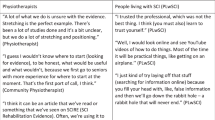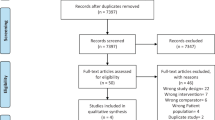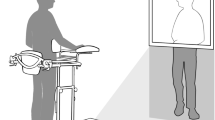Abstract
Study design:
A pilot randomised controlled trial.
Objectives:
The aims of this study were to evaluate the effectiveness and participant satisfaction of web-based physiotherapy in people with spinal cord injury (SCI).
Setting:
Community patients of a national spinal injury unit in a university teaching hospital, Scotland, UK.
Methods:
Twenty-four participants were recruited and randomised to receive 8 weeks of web-based physiotherapy (intervention), twice per week, or usual care (control). Individual exercise programmes were prescribed based on participants' abilities. The intervention was delivered via a website (www.webbasedphysio.com) and monitored and progressed remotely by the physiotherapist.
Results:
Participants logged on to the website an average of 1.4±0.8 times per week. Between-group differences, although not significant, were more pronounced for the 6-min walk test. Participants were positive about using web-based physiotherapy and stated that they would be happy to use it again and would recommend it to others. Overall, it was rated as either good or excellent.
Conclusions:
Web-based physiotherapy was feasible and acceptable for people with SCI. Participants achieved good compliance with the intervention and rated the programme highly and beneficial for health and well-being at various states after injury. The results of this study warrant further work with a more homogeneous sample.
Sponsorship:
This study was funded by the Queen Elizabeth National Spinal Injuries Unit, Glasgow, UK.
Similar content being viewed by others
Log in or create a free account to read this content
Gain free access to this article, as well as selected content from this journal and more on nature.com
or
References
Groah SL, Weitzenkamp D, Sett P, Soni B, Savic G . The relationship between neurological level of injury and symptomatic cardiovascular disease risk in the aging spinal injured. Spinal Cord 2001; 39: 310–317.
Whiteneck GG, Charlifue SW, Frankel HL, Fraser MH, Gardner B, Gerhart KA et al. Mortality, morbidity, and psycho-social outcomes of persons spinal cord injured more than 20 years ago. Paraplegia 1992; 30: 617–630.
Bauman WA, Alexander LR, Zhong Y-G, Spungen AM . Stimulating leg ergometry training improves body composition and HDL-cholesterol values. J Am Parapleg Soc 1994; 17: 201.
Hetz SP, Latimer AE, Buchholz AC, Martin Ginis KA . Increased participation in activities of daily living is associated with lower cholesterol levels in people with spinal cord injury. Arch Phys Med Rehabil 2009; 90: 1755–1759.
Nooijen CFJ, de Groot S, Postma K, Bergen MP, Stam HJ, Bussmann JBJ et al. A more active lifestyle in persons with a recent spinal cord injury benefits physical fitness and health. Spinal Cord 2012; 50: 320–323.
Santiago M, Coyle C . Leisure-time physical activity and secondary conditions in women with physical disabilities. Disabil Rehabil 2004; 26: 485–494.
Hicks AL, Martin Ginis KA, Ditor DS, Latimer AE, Craven C, Bugaresti J et al. Long-term exercise training in persons with spinal cord injury: effects on strength, arm ergometry performance and psychological well-being. Spinal Cord 2003; 41: 34–43.
Hicks AL, Martin Ginis KA, Pelletier CA, Ditor DS, Foulon B, Wolfe DL . The effects of exercise training on physical capacity, strength, body composition and functional performance among adults with spinal cord injury: a systematic review. Spinal Cord 2011; 49: 1103–1127.
Scelza WM, Kalpakjian CZ, Zemper ED, Tate DG . Perceived barriers to exercise in people with spinal cord injury. Am J Phys Med Rehabil 2005; 84: 576–583.
Rimmer JH, Rubin SS, Braddock D . Barriers to exercise in African American women with physical disabilities. Arch Phys Med Rehabil 2000; 81: 182–188.
Keyser RE, Rasch EK, Finley M, Rodgers MM . Improved upper-body endurance following a 12-week home exercise program for manual wheelchair users. J Rehabil Res Dev 2003; 40: 501–510.
Latimer AE, Ginis KAM, Arbour KP . The efficacy of an implementation intention intervention for promoting physical activity among individuals with spinal cord injury: a randomized controlled trial. Rehabil Psychol 2006; 51: 273–280.
Kairy D, Lehoux P, Vincent C, Visintin M . A systematic review of clinical outcomes, clinical process, healthcare utilization and costs associated with telerehabilitation. Disabil Rehabil 2009; 31: 427–447.
Kim J, Lim S, Yun J, Kim D-H . Telerehabilitation needs: a bidirectional survey of health professionals and individuals with spinal cord injury in South Korea. Telemed J E Health 2012; 18: 713–717.
Kowalczewski J, Chong SL, Galea M, Prochazka A . In-home tele-rehabilitation improves tetraplegic hand function. Neurorehabil Neural Repair 2011; 25: 412–422.
Van Staaten M, Cloud B, Morrow M, Ludewig P, Zhao K . Effectiveness of home exercise on pain function and strength of manual wheelchair users with SCI: a high dose shoulder program with telerehabilitation. Arch Phys Med Rehabil 2014; 95: 1810–1817.
Gaffurini P, Bissolotti L, Calza S, Calabretto C, Orizio C, Gobbo M . Energy metabolism during activity-promoting video games practice in subjects with spinal cord injury: evidences for health promotion. Eur J Phys Rehabil Med 2013; 49: 23–29.
Paul L, Coulter EH, Miller L, McFadyen A, Dorfman J, Mattison PGG . Web-based physiotherapy for people moderately affected with Multiple Sclerosis; quantitative and qualitative data from a randomized, controlled pilot study. Clin Rehabil 2014; 28: 924–935.
Cowan RE, Callahan MK, Nash MS . The six minute push test is reliable and predicts low fitness in spinal cord injury. Med Sci Sports Exerc 2012; 44: 1993–2000.
Lam T, Noonan VK, Eng JJ . A systematic review of functional ambulation outcome measures in spinal cord injury. Spinal Cord 2008; 46: 246–254.
Borg GA . Psychophysical bases of perceived exertion. Med Sci Sports Exerc 1982; 14: 377–381.
Bohannon RW . Make tests and break tests of elbow flexor muscle strength. Phys Ther 1988; 68: 193–194.
Zigmond AS, Snaith RP . The Hospital Anxiety and Depression Scale. Acta Psychiatr Scand 1983; 67: 361–370.
Skevington SM, Lotfy M, O’Connell KA . The World Health Organization’s WHOQOL-BREF quality of life assessment: psychometric properties and results of the international field trial. A report from the WHOQOL group. Qual Life Res 2004; 13: 299–310.
Müller R, Cieza A, Geyh S . Rasch analysis of the Hospital Anxiety and Depression Scale in spinal cord injury. Rehabil Psychol 2012; 57: 214–223.
Jang Y, Hsieh C-L, Wang Y-H, Wu Y-H . A validity study of the WHOQOL-BREF assessment in persons with traumatic spinal cord injury. Arch Phys Med Rehabil 2004; 85: 1890–1895.
Finkelstein J, Lapshin O, Castro H, Cha E, Provance PG . Home-based physical telerehabilitation in patients with multiple sclerosis: a pilot study. J Rehabil Res Dev 2008; 45: 1361–1373.
Sluijs EM, Knibbe JJ . Patient compliance with exercise: different theoretical approaches to short-term and long-term compliance. Patient Educ Couns 1991; 17: 191–204.
Noreau L, Shephard RJ, Simard C, Paré G, Pomerleau P . Relationship of impairment and functional ability to habitual activity and fitness following spinal cord injury. Int J Rehabil Res 1993; 16: 265–275.
Acknowledgements
This study was funded by the Queen Elizabeth National Spinal Injuries Unit, Glasgow. We thank Mr David Collins and the individuals with SCI for filming the exercises. We also thank Sister Karen McKarron, Nurse Laura McLean and Dr Mariel Purcell for their assistance in recruitment. Finally, we thank the study participants for taking part in the study.
Author information
Authors and Affiliations
Corresponding author
Ethics declarations
Competing interests
The website, www.webbasedphysio.com, was developed by two of the authors (EHC, LP) at the University of Glasgow. However, as this is not a commercial entity there are no conflicts of interest. All the other authors declare no conflict of interest.
Rights and permissions
About this article
Cite this article
Coulter, E., McLean, A., Hasler, J. et al. The effectiveness and satisfaction of web-based physiotherapy in people with spinal cord injury: a pilot randomised controlled trial. Spinal Cord 55, 383–389 (2017). https://doi.org/10.1038/sc.2016.125
Received:
Revised:
Accepted:
Published:
Issue date:
DOI: https://doi.org/10.1038/sc.2016.125
This article is cited by
-
Perceptions of a self-guided web-based exercise programme for shoulder pain after spinal cord injury: A qualitative study
Spinal Cord (2023)
-
Online physiotherapy for people with axial spondyloarthritis: quantitative and qualitative data from a cohort study
Rheumatology International (2023)
-
Physical exercise intervention via telerehabilitation in patients with neurological disorders: a narrative literature review
The Egyptian Journal of Neurology, Psychiatry and Neurosurgery (2022)
-
Feasibility of home hand rehabilitation using musicglove after chronic spinal cord injury
Spinal Cord Series and Cases (2022)
-
Current Approaches in Telehealth and Telerehabilitation for Spinal Cord Injury (TeleSCI)
Current Physical Medicine and Rehabilitation Reports (2022)



